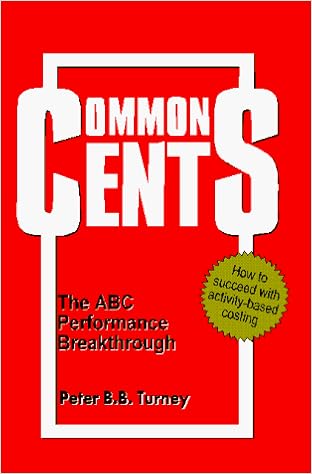
 In the 1990s there was a wave of euphoria about cost accounting and particularly Activity Based Costing (ABC). One book in particular stands out in my mind as particularly euphoric: Common Cents: The ABC Performance Breakthrough by Stephen Turney. While it had a clever title, few people remember this book now, but many people remember ABC. Many finance and budget managers do not recall ABC with fondness. In fact, when government budget and finance managers are asked about the use of ABC in their organizations now, most will say that they are not using it. However, when asked if they are doing some form of cost accounting, the measure is much higher. In this post, I explore why budget and finance managers are willing to say that they are doing cost accounting and not ABC. I further explore (and mix) the metaphor of common sense/cents about cost accounting by thinking of its uses as two sides of the same coin.
In the 1990s there was a wave of euphoria about cost accounting and particularly Activity Based Costing (ABC). One book in particular stands out in my mind as particularly euphoric: Common Cents: The ABC Performance Breakthrough by Stephen Turney. While it had a clever title, few people remember this book now, but many people remember ABC. Many finance and budget managers do not recall ABC with fondness. In fact, when government budget and finance managers are asked about the use of ABC in their organizations now, most will say that they are not using it. However, when asked if they are doing some form of cost accounting, the measure is much higher. In this post, I explore why budget and finance managers are willing to say that they are doing cost accounting and not ABC. I further explore (and mix) the metaphor of common sense/cents about cost accounting by thinking of its uses as two sides of the same coin.
Some background on cost accounting…
Cost accounting is the measurement and use of both direct and indirect cost information for an organizational purpose like rate setting, grant overhead recovery, performance measurement or cost management. For private businesses, cost accounting is essential for pricing goods and services. In government, cost accounting has many uses as well. It can be used to price goods as businesses do, to collect overhead for grants, and to improve performance measurement systems. These are all beneficial uses that are broadly supported by most organizations. The other side of the coin is that cost accounting can be used for intensive cost management purposes, but these uses may generate resistance in organizations. Intensive cost management such as contracting out services and service cutbacks or eliminations can generate resistance from employees. It is important for managers and budget officers that are looking to use cost accounting for the first time, or more intensively, to consider both sides of the coin and plan accordingly.
 The easy side of the cost accounting coin
The easy side of the cost accounting coin
– Collecting grant overhead
– Accurately price goods or services
– Improve performance management systems
In my research and as described in my forthcoming edited book, cost accounting has many acknowledged uses in government. The oldest use of cost accounting was to collect grant overhead costs from the federal government as described in the A-87 circular. The benefit of A-87 cost accounting is that when local governments provide federal services that they should be able to charge indirect costs like HR, IT, and Accounting costs to the grant so that the local government does not have to subsidize services that are most appropriately paid for by the federal government.
Cost accounting also has an important place in accurately pricing goods and services that government “sells” to consumers. Like federal grants, services that are sold to private consumers need to have indirect costs added into them so that the general tax is not unintentionally subsidizing the service. Finally, cost accounting is important for performance management systems. The work of the North Carolina Benchmarking Program most directly speaks to this issue. Without cost accounting, we cannot be sure if performance differences come from differences in processes that we can learn from or whether they come from simple differences in resources. Generally, few people inside an organization object to these purposes and may readily assist if they believe that it can be used to generate new revenues for their programs.
 The difficult side of the cost accounting coin
The difficult side of the cost accounting coin
– Contracting out services
– Service cutbacks and eliminations
– Overhead cost management
Cost accounting also has some more difficult uses. I suggest that these are difficult only because they are difficult for people in the organization. Analysts and managers have told me that people believe that when the government starts collecting data on the “full” cost of services they think that sweet Ms. Betty in Animal Licenses is going to lose her job. They believe this because cost accounting allows governments to more accurately estimate the benefit associated with contracting or eliminating services. If we only look at the budgeted costs of a services like animal licensing, we leave out important indirect costs or the budgeted cost is aggregated at such a level that it obscures the individual cost of services. So, cost accounting can be used to both combine direct and indirect costs and track expenses at a more granular level, which becomes very beneficial for contracting and service analysis.
Cost accounting also often shows that building space, which is an often untracked overhead expense in the budget, is an important cost of services. If the cost of building space is added into the cost estimate, the service managers often have to justify the high cost of the space for things like storage. This is something that managers do not want to have to justify and defend.
The improved ability to evaluate contracting, service elimination, and overhead cost management are all important and appropriate uses of cost accounting from the budget officer’s perspective. However, this side of the coin may appear negative from the employee and service manager’s perspective, and organizational resistance may ensue. Often this resistance is seen in the form of service managers focusing on the excessive time and data requirements of cost accounting.
My common sense suggestions about both sides of the cost accounting coin
The previous discussion of the “other” side of the coin that generates resistance in the organization has suggested why cost accounting (and ABC in particular) has been limited in government. If the resistance hypothesis is correct, then the next question is what can be done about it? In my forthcoming edited book and in my dissertation (found here: see chapter 3 in particular), I note that the cost accounting used in practice by local governments is not completely an ABC cost accounting system, which may help this problem of resistance and minimize the time and data requirements. I call this development “hybrid” cost accounting. These hybrid cost accounting systems are neither very basic or exactly like ABC. They have a mix of basic and specific cost drivers, the level of cost is passed down to some broad programs and some very specific activities, and that the “fullness” of the system is mixed. In other words, the systems that are developed and used by cities over time are not purebred ABC systems. The system is more basic in areas where it is not as important to have a specific activity cost and in areas that generate the most resistance.
Additionally, many cities have found that they have multiple cost accounting systems for different purposes like A-87 cost accounting plans for federal grants and then “full” cost accounting for purposes of setting rates and evaluating the cost of services. All of this points to the new understanding that there needs to be multiple estimates of cost for the multiple purposes of government.
In conclusion, cost accounting has many significant benefits for government, but we have to use some common sense about our expectations for cost accounting and how it will be received by the organization. In other words, we need to consider both sides of the coin and especially from the perspective of the service managers and employees. By using hybrid cost accounting systems and multiple cost systems, we may be able to minimize the resistance from the organization and maximize benefits.
Zach Mohr is an Assistant Professor at UNC Charlotte. He has a forthcoming, edited book on cost accounting titled Cost Accounting in Government: Theory and Applications. It will be published by Routledge in May 2017. Links to actual local government cost accounting documents and other useful cost accounting resources can be found on his faculty website.
